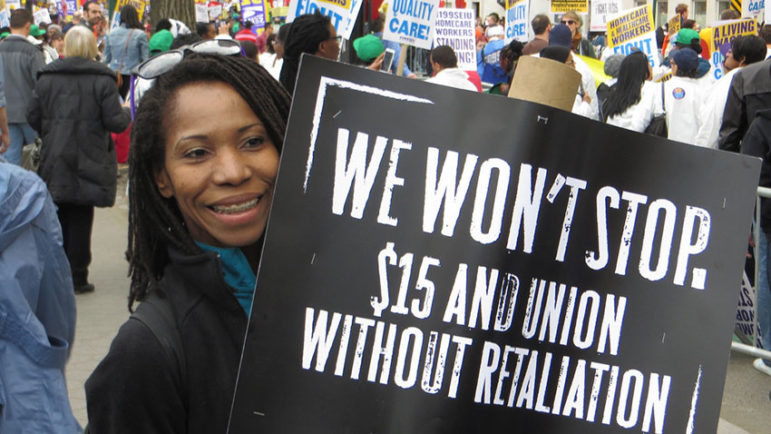
November 29, 2016; FiveThirtyEight
Our readers may note that NPQ has long been following the development of the “Fight for 15” movement. This past Tuesday marked the four-year anniversary of the movement’s first protest event, back in November 2012. The National Employment Law Project (NELP) reminds us that the date marks the day that New York City’s fast food workers first “walked off their jobs demanding $15 an hour and union rights.” The movement has come a long way. While 200 workers took part in that one-day strike four Novembers ago, thousands have now risen nationwide, spanning across 340 cities to mark the event. Chicago O’Hare airport alone witnessed 500 workers on strike.
The movement has not only continued, but grown. Its growth keeps the U.S. political debate over minimum wage on the agenda. The movement is credited for notable victories in passing $15 minimum wage laws that would phase in over the next few years. Indeed, voters nationwide have approved minimum wage increases by 2020, as reflected in wage ballots. There were prominent victories in the District of Columbia and across state legislatures in California, N.Y., and Washington.
A NELP report further debriefs us on the movement’s impact. According to the report, pay increases for 17 million Americans can be attributed to the movement; altogether, these increases amount to $61.5 billion, “more than 10 times larger than the total raise received by workers in all 50 states under Congress’s last federal minimum wage increase, approved in 2007.” The report also indicates that pressure from the movement may have led to voluntary wage hikes in prominent companies that include Walmart and Starbucks.
The numbers appear impressive. However, readers ought not draw too many conclusions. While optimism is certainly justified, these estimates could benefit from further validation. For instance, the numbers are said to come directly from advocacy groups like NELP. While the momentum and the energy of the movement are an achievement, why risk potential setbacks that could be blamed on overestimation, especially this far in the game? Though trends indicate motion in a positive direction, the minimum wage laws some states have passed will take time to phase in. In the meantime, we are gearing up for an upcoming presidential transition with a very different mindset about supporting a federal $15 minimum wage requirement, let alone having businesses feel the need to opt more for union membership “loopholes.”
Sign up for our free newsletters
Subscribe to NPQ's newsletters to have our top stories delivered directly to your inbox.
By signing up, you agree to our privacy policy and terms of use, and to receive messages from NPQ and our partners.
There are also gaps in the data with respect to whether the increased wages for lower paid workers were the result of state-mandated minimum wage laws or whether they had more to do with booming local economies and market forces including the high labor turnover rates common in entry-level positions. After all, even the report concedes “at most, 25 percent of the observed earnings gained…can be attributed to the minimum wage.”
Also, the report is said to include workers who already earn more than minimum wage, many of whom will have their pay raised due to ripple effects. Yet, such effects can be unpredictable. This may ring especially true for nonprofit organizations, which, with changes to the federal FLSA overtime regulations (now blocked by a federal judge), may have to resort to making once-exempt employees non-exempt and having them work “on the clock” instead of providing them with salaries that are beyond budget limits.
While research at times links even modest wage increases to slight positive improvements in employment outcomes, unfortunately, as even liberal economists acknowledge, “a $15 minimum wage is uncharted territory.” In March, the New York Times quoted Ben Zipperer of the Washington Center for Equitable Growth as he explained that despite the greater benefits coming from the fact that the minimum wage increase “covers a greater share of the workforce than for past minimum wage increases, the risks of these costs are also higher.” NPQ has covered news pointing out how proportioning wage increases across staff levels, while ideal, can unfortunately risk lowering the performance levels of many nonprofit programs and services.
On the brighter side, we have yet to see evidence of any negative effects from the increase toward $15. At least in the restaurant and retail industries, there have been no links between any state’s wage increases and limits to job growth.
Bridging data gaps should underscore the popularity and promise of the “Fight for 15” movement, focusing on aiming to make it work across sectors. As of now, however, the movement’s most significant legacy, like NELP’s Paul Sonn points out, is that it involves “workers setting the policy agenda.” More is sure to come.—Noreen Ohlrich











